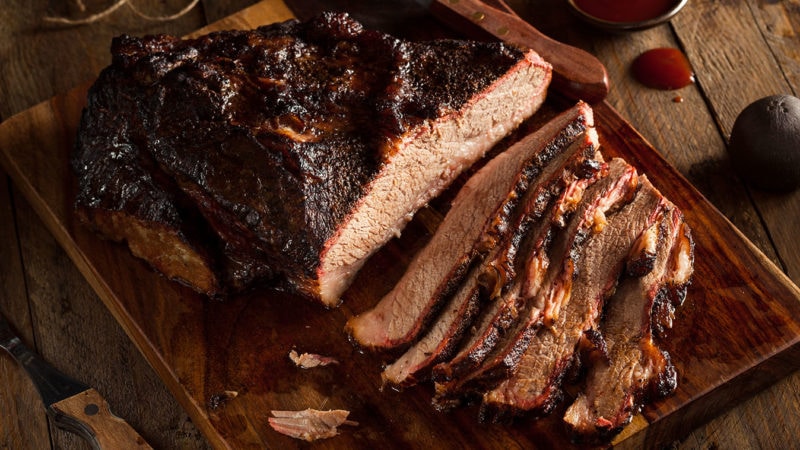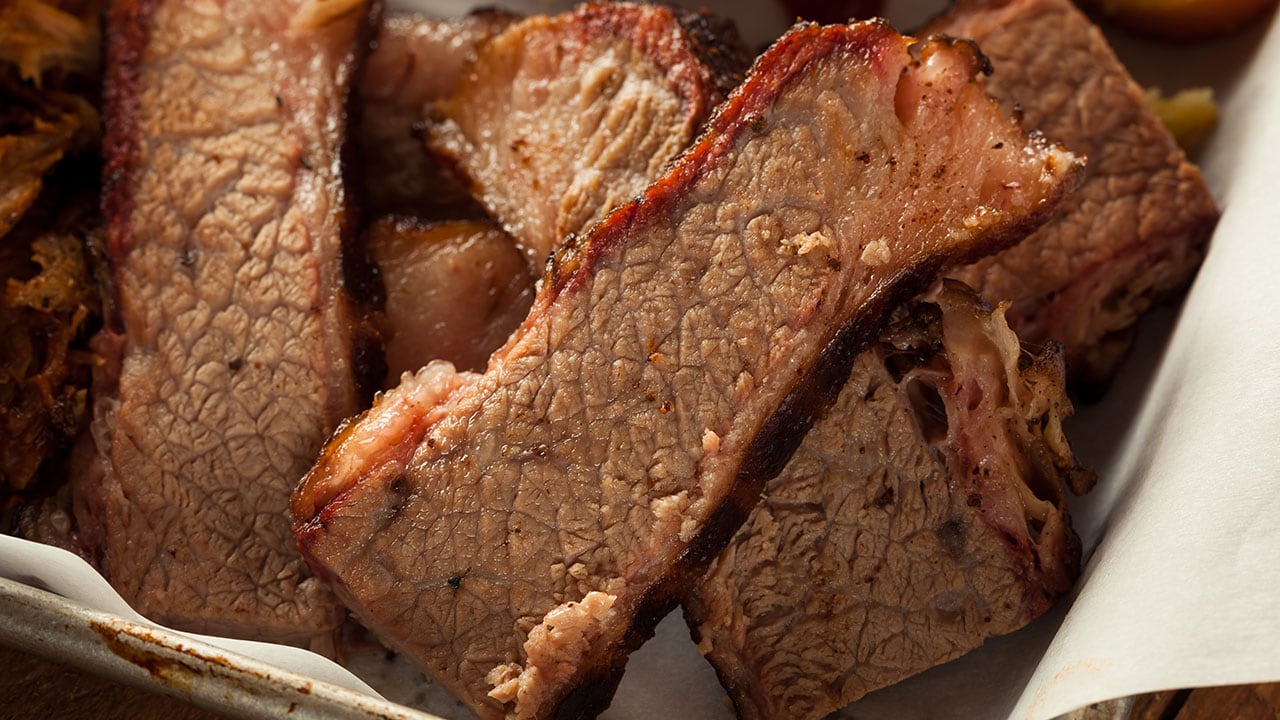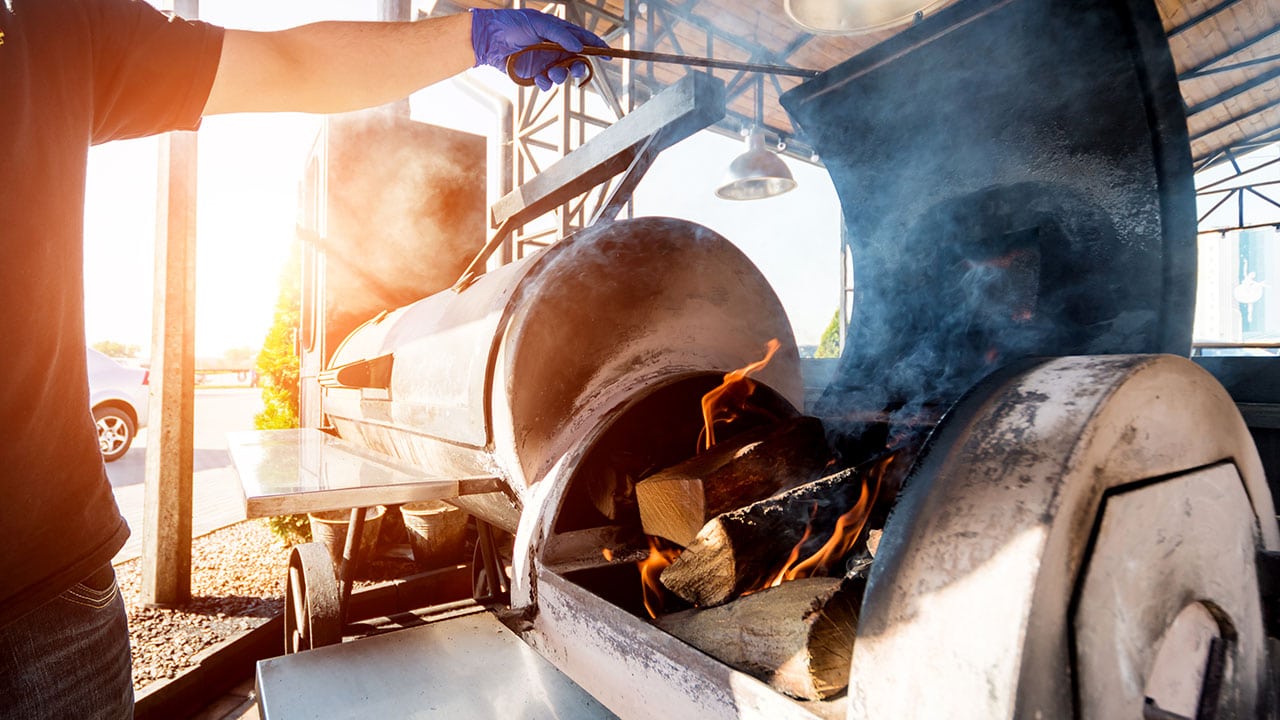Last Updated on December 6, 2022
If your mouth starts watering at the mention of juicy brisket, then it’s time to learn how to cook brisket for the first time and tackle it at home.
Few things are as soul-satisfying as a fall-apart tender slice of beef brisket, complete with crispy bark or an unbelievable gravy made from its braising juices.
There are so many ways to prepare BBQ beef brisket. Whether it’s smoked beef brisket, corned beef brisket, Texas-style smoked brisket, or simply low and slow brisket in the oven. For this reason, some of us find it a bit intimidating to prepare at home. With all of the barbecue pros and barbecue competition lovers who seemed to have mastered the “Art of Brisket” in our heads, there’s a lot of pressure.
This guide is here to demystify the different ways how to cook brisket for the first time at home, from smoking it traditionally to using an Instant Pot. First, a little bit of background on brisket.
What is Brisket?
Complete with tempting fat and gorgeous grain, brisket is the holy grail cut of beef for barbecue enthusiasts. It’s also a popular cut of meat in many cuisines, including traditional Jewish cooking.
One of the nine primal cuts of beef, brisket comes from the lower front of the animal, near its front legs. Essentially, brisket is the animal’s breast; it is also one of the most used muscle sections — specifically the deep pectoral muscle and the superficial pectoral muscles. Brisket is often divided into two portions: The brisket flat and the brisket point.
As a cut, brisket can be very tough. It requires three things to achieve the tenderness level it is known for in the barbecue world: Moisture, low heat, and time. For this reason, brisket is a labor of love. But oh, is it worth it, thanks to its rich, mouthwatering flavor.
How to Season a Brisket
Like any large cut of beef, there are myriad ways you can flavor your brisket. Even if you’re cooking brisket for the first time from home, you can still get creative. For something that is a bit more traditional, use ingredients that add sweetness—like dried apricots or molasses. Or, add Madeira wine to your brisket.
You can opt for the Texas barbecue route, too. For that, you’d need simple seasonings like salt, pepper, garlic, and a whole lot of hardwood smoke. Keep reading for a breakdown on how to smoke a brisket.
Lastly, you could veer into the savory and salty path. Try braising your brisket in red wine, beef stock, and tomato paste, or even dry-brining your brisket with salt and key seasonings to make corned beef.
How to Smoke a Brisket
Who doesn’t love a brisket smoked low and slow, with a crispy black bark and pink interior? While brisket is the darling of many barbecue pros, you don’t have to be intimidated by the process of smoking brisket at home.
Settle in for a day spent smoking your brisket to perfection.
There are a few key steps to follow:
- Trim your brisket. Many people trim their briskets of extra fat, like in the fat cap, or they’ll leave about a ¼ inch of fat. It’s a personal call.
- Season your brisket simply, but liberally. All you need is a blend of salt, pepper, and garlic powder. This can be done the night before. Be sure to take your brisket out for an hour to let it come to room temperature.
- Get your smoker set to 225°F to 250°F, or rig up your own grill to serve as a smoker with hardwood chips and indirect heat. You can create moisture and humidity (great for your brisket) by using a pan filled with water in the smoker.
- Place your brisket fat-side up in the smoker. Depending on its size, your brisket will need to smoke for around three hours undisturbed. Then, you can check on it every 30 minutes.
- Cook through the stall. This is a period where the brisket may not seem to climb in temperature very quickly. It’s all a part of the process. Your brisket should be done when it reaches an internal temperature between 200°F and 210°F. Let it rest for at least an hour.
Try Your Brisket in the Oven
Oven-braised brisket is a staple of many people’s childhoods. Often, it was served at a celebratory dinner or holiday meal. The key to these moist and tender briskets is a low and slow braise in the oven. Here’s an easy method to oven braise a brisket.
- Start with a Dutch oven with a tightly fitting lid. You’ll want to retain all that good moisture to braise a brisket. Preheat the oven to 325℉.
- Sear your brisket on the stove. Seal in all that good flavor and create a crust, though be careful not to start the cooking process too fast. Two minutes a side should suffice.
- Build your braising liquid. Your preferred braising liquid and seasonings work here – see our suggestions earlier for a jumping-off point.
- Braise away. Depending on the size of your brisket, this could take four hours or longer.
- Let it rest. Oven-braised brisket needs about 30 minutes to rest. Then, dig in and serve with the braising liquid as a sauce.
A Few Novel Ways to Cook a Brisket
We’ve covered the two most common ways to prepare brisket: Smoking and oven-braising. But, there are a few new kitchen tools that make preparing a brisket easy as can be.
- Instant Pot: This programmable pressure cooker significantly cuts down the time to achieve a moist, delicious brisket. In fact, with this simple recipe, you can cook your brisket in as little as 70 minutes (plus time to come up to pressure). Another idea? Give your brisket one hour on the smoker, and one hour in the pressure cooker. Heaven.
- Slow Cooker: This is kind of a given since a slow cooker essentially accomplishes the same feat as the oven-braising method. Still, if you don’t want to leave your oven on for hours, the slow cooker offers an easy fix.





